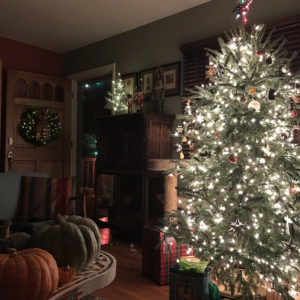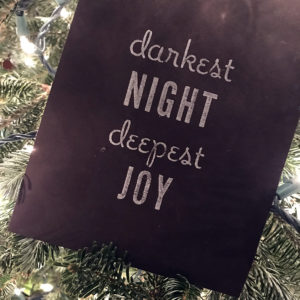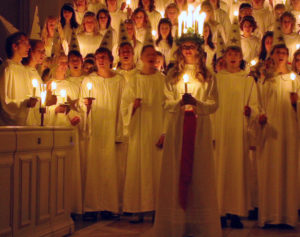And now it is Christmas. It is my favorite part of Christmas as I write this, the deep and dark hours of the night of Christmas Eve, well past midnight, in the close and holy darkness. Our traditional Italian dinner of many fishes is past and so is all the hustle and hubbub: Things that did not get done in time for Christmas’ arrival remain undone and suddenly it doesn’t matter anymore; we’ll just do them as time allows through the Christmas season, or maybe we’ll save them for next Christmas. Despite the darkness, all is bright: the tree, which is illuminated but still not completely decorated, and the wreath on the door, and the lights on the European fan palms outside the door. Tomorrow we can finish decorating the tree.
We have reached the peaceful time of Christmas, this late night. It is the time when all the magic traditionally occurs: the gift bearers who sneak in presents beneath the tree and into empty stockings, the animals who kneel, the wells and rivers that run with wine, the star and the child, all that Christmas means to anyone happens now in this night of calm and bright. The magic sometimes is as simple as memories of Christmases come and gone. I sit here with the lighted tree and remember all the people who have come and gone through my Christmases. My grandparents, aunts and uncles, my dad. I think of the neighbors across the street when I was a boy, Mildred and Paul, who decorated their front door with big multicolor Christmas lights each year: a single strand of lights, the old fashioned kind, the kind with bulbs you screw in, stapled to the doorframe. A magical portal if ever there was one. I last saw Mildred and Paul and their portal of lights 43 years ago, and yet this is what comes to mind as I sit here tonight, and it comes back to me, fresh as if it was yesterday. This is Christmas magic for you.
Remember through these days to come that Christmas has just begun. This magical night ushers in Christmas Day, and though there are two schools of thought on how to calculate the Twelve Days of Christmas, we subscribe to the venerable one that places the first six days of Christmas in the old year and the next six days of Christmas in the new. Our ancestors liked balance and so it seems only right, to us, anyway. Please join us in celebrating Christmas through all these days, to the season’s close on Epiphany, the 6th day of January. If your heart truly loves Christmas, do things in your own time, and know that in many traditions, Christmas is a season that carries on all the way to Candlemas, on the 2nd of February. Do what feels right to you, that’s my recommendation. Even if it seems out of step with the dominant culture. At this house, we will be doing just that.
In years past I’ve written each day for the Twelve Days of Christmas, but I don’t know that that will be the case this year. We’ve a garden fence to build, and raised beds to plant, and still there are the ornaments to place on the tree. I’ll write when I can, I promise, but it won’t be every day. My recommendation? Stock up on red wine and mulling spices and chestnuts, for mulled wine and roasted chestnuts are an important part of Christmas and the twelve nights that follow it. We sell some wonderful mulling spices and we can get them to you in a couple of days in most cases: plenty of time for the celebrations ahead. You can also check out past editions of the Convivio Book of the Days to learn more about what is traditional for each day of Christmas.
For now, though: Merry Christmas.


